Big and small, cute and creepy, you can find so many kinds of fish that start with the letter H. Examples range from the eel-shaped hagfish to the ferocious hammerhead shark. While some of these fish reside in rivers or lakes, others dwell along coral reefs or in the open ocean. Let’s explore 15 fish whose common names start with the letter H!
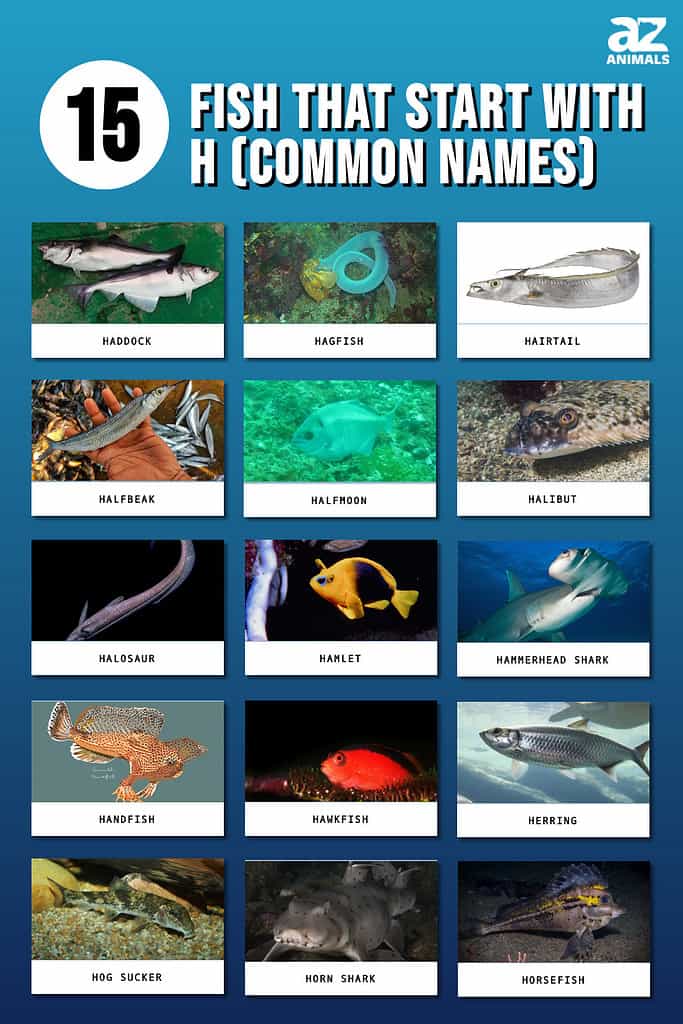
1. Haddock (Melanogrammus aeglefinus)

Similar to cod, haddock is often caught for culinary purposes.
©Solodov Aleksei/Shutterstock.com
You’ve likely encountered haddock before while shopping at your local supermarket. The haddock belongs to the true cod family, Gadidae.
This saltwater ray-finned fish originates from the northern Atlantic Ocean. You can find haddock at depths ranging from 30 to 1,500 feet below the surface. It possesses a long, greyish-brown body that measures between 12 and 37 inches long.
Due to its mild taste, haddock ranks as one of the most popular food fish caught by North American and European fisheries. Unfortunately, the IUCN lists haddock as a Vulnerable species due to overfishing.
2. Hagfish (Myxinidae)
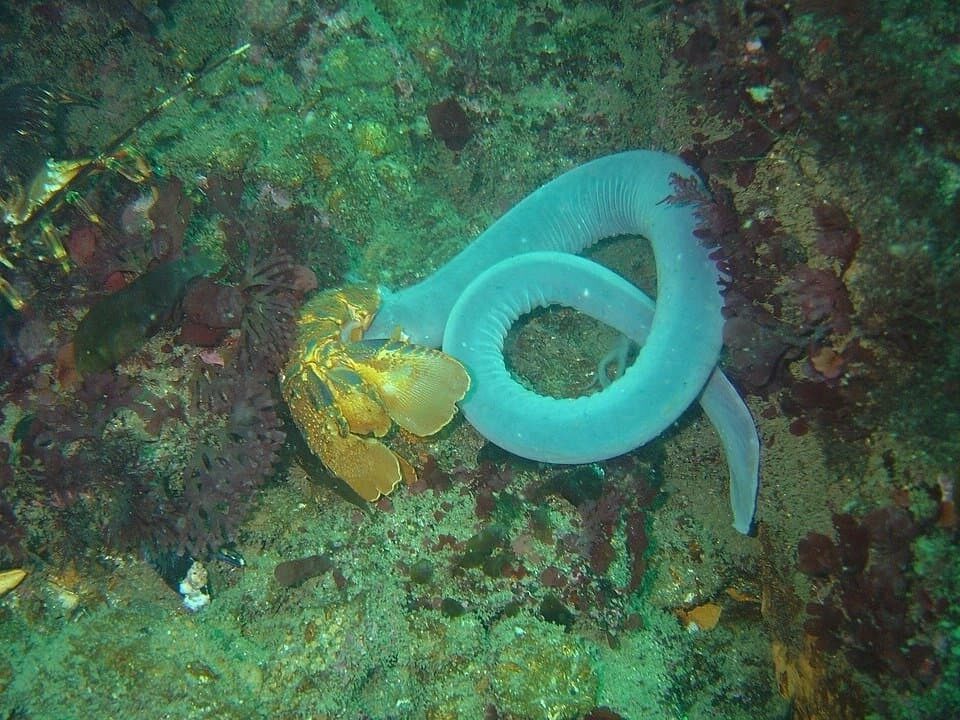
The hagfish has a skull but no spinal column or jaws.
©Peter Southwood / CC BY-SA 3.0 – License
Hagfish are some of the oddest-looking fish in the ocean. These eel-shaped marine fish produce milky mucus to protect themselves from predators or when agitated.
Hagfish possess a skull but no spinal column and no jaws. While they can grow up to 4 feet long, most specimens measure less than 20 inches in length. They feature no true fins and are equipped with barbels around the mouth that help them to locate food.
Hagfish feed primarily on marine worms as well as dead or dying sea creatures. South Korea represents the only country in the world where people regularly eat hagfish.
3. Hairtail (Trichiuridae)
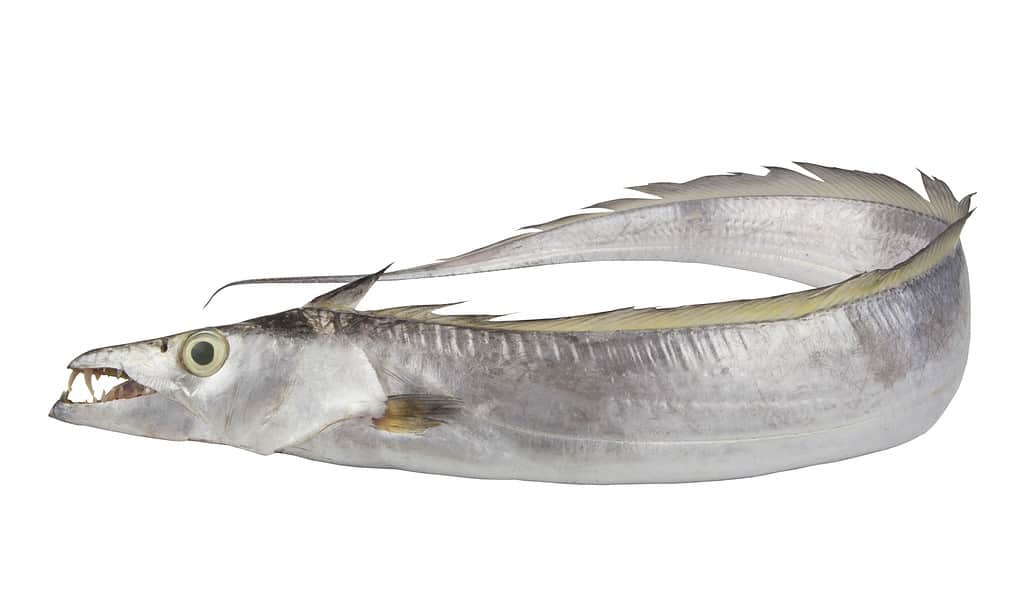
Hairtails get their name from their long, slender bodies that can grow up to 8 feet long.
©iStock.com/Valerii Evlakhov
Hairtail fish also go by the name cutlassfish or beltfish. Well-known hairtail species include the largehead hairtail (Trichiurus lepturus), Savalai hairtail (Lepturacanthus savala), and New Guinea hairtail (Demissolinea novaeguineensis). You can typically find hairtails in tropical or temperate waters.
Hairtails get their name from their long, slender bodies that can grow up to 8 feet long. In addition to their long bodies, you can also identify them by their large, fang-like teeth.
These predatory fish feed on smaller animals like krill when young and on other fish as adults. Numerous fisheries target the larger hairtail species as food fish.
4. Halfbeak (Hemiramphidae)
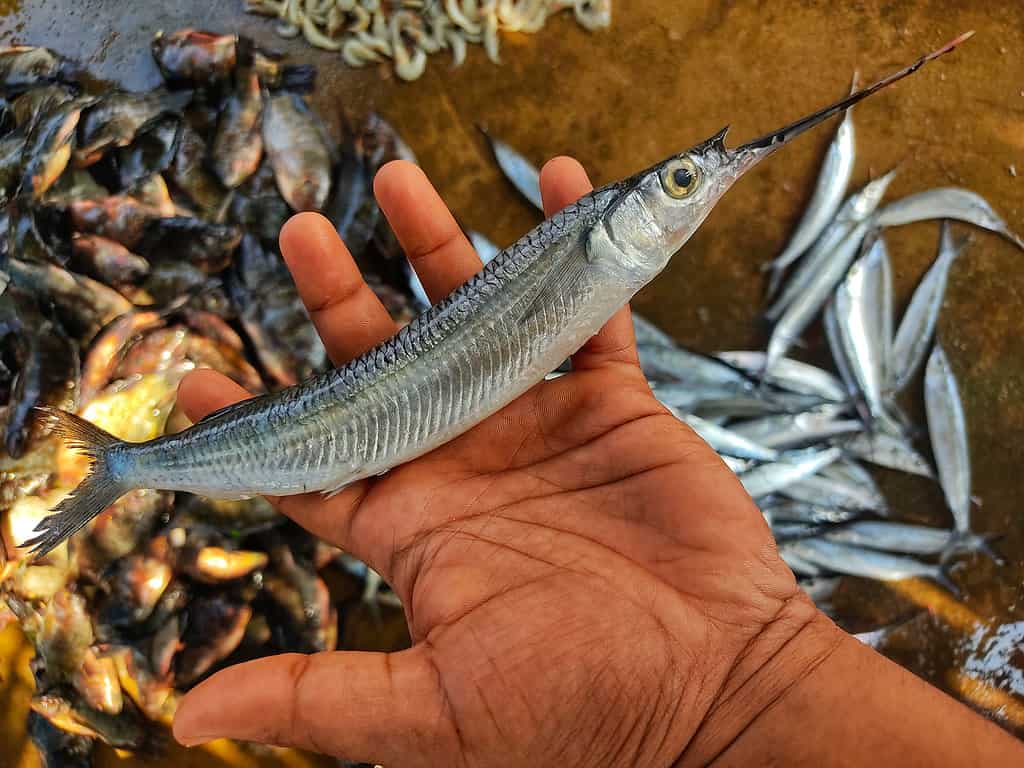
Halfbeaks get their name from their unique appearance, as the lower jaws are abnormally larger than the upper jaws.
©iStock.com/Biswa1992
You may also know the halfbeak by its other common name, the spipefish. Halfbeaks enjoy a widespread distribution around the world, although they typically inhabit warm water close to the surface.
Halfbeaks get their name from their unique appearance, as the lower jaws are abnormally larger than the upper jaws. They can grow up to 16 inches long and generally appear gray or silver.
Their diet consists mainly of algae, plankton, crustaceans, and small fishes. Most halfbeaks live in schools, and some species, such as the flying halfbeaks, can jump out of the water and glide for short distances.
5. Halfmoon (Medialuna californiensis)

Halfmoons can grow up to a maximum size of 19 inches long.
©Chris Teague, CC BY 3.0 – License
Also known as the blue perch, the halfmoon belongs to the sea chub subfamily Scorpidinae. It lives off the western coast of North America from Vancouver Island to the Gulf of California. You can often find halfmoons near kelp forests and rocky reefs.
Halfmoons feature a flat, oval-shaped body and a small jaw lined with sharp teeth. The body appears blue-gray aside from a dark patch near the gill covers. They can grow up to a maximum size of 19 inches long.
Recreational anglers often target halfmoons while rod and reel fishing. Additionally, commercial fisheries frequently catch halfmoons as food fish.
6. Halibut (Pleuronectidae)
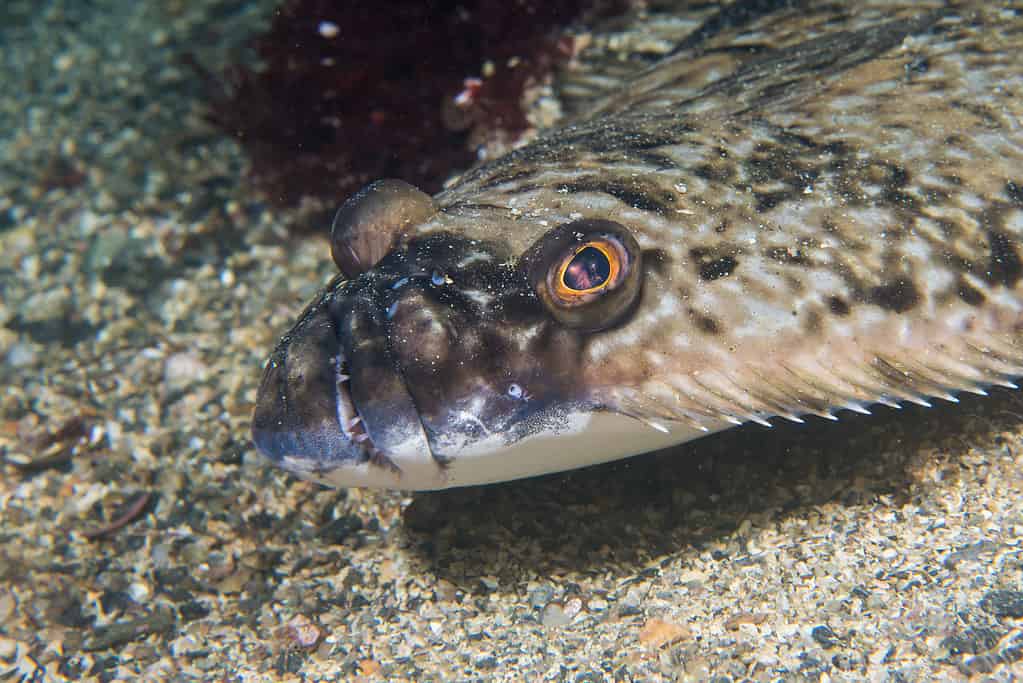
The Atlantic halibut is a flatfish.
©Joern_k/Shutterstock.com
Halibut is one of the most well-known fish that starts with the letter H. The term halibut actually refers to three species in the right-eye flounder family Pleuronectidae. You can find halibut throughout the northern Pacific, Atlantic, and Arctic Oceans. They typically live near rocky or sandy bottoms at depths up to 6500 feet below sea level.
The Atlantic halibut (Hippoglossus hippoglossus) ranks as the largest flatfish species in the world. Large specimens can weigh over 500 pounds and measure more than 8 feet long. The dorsal side typically looks dark brown, while the ventral side appears white.
These giant predators will eat pretty much anything they can catch. Halibut are often caught both as a sport fish and food fish due to their size and taste.
7. Halosaur (Halosauridae)
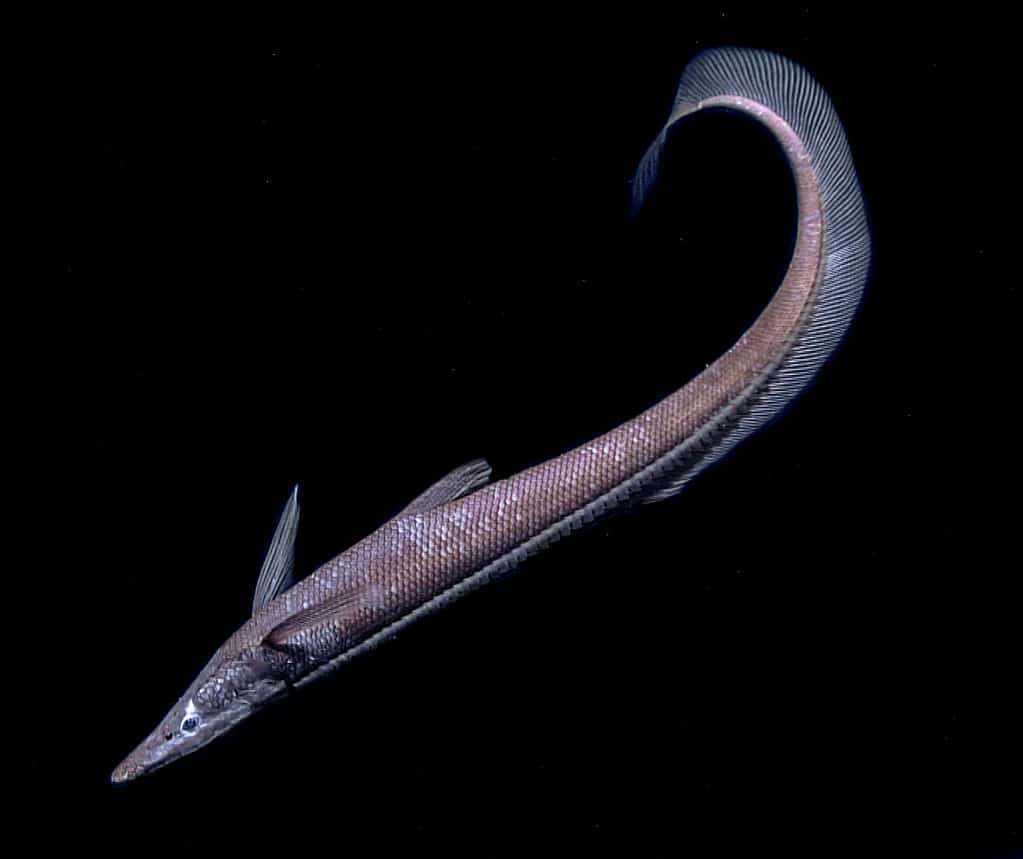
Halosaurs use their lateral line system to detect water vibrations and find food.
©NOAA Ocean Exploration & Research from USA, CC BY-SA 2.0 – License
The halosaur is another eel-shaped fish that begins with the letter H. The family Halosauridae contains around 17 different species spread across 3 extant genera. You can find these deep-dwelling fish all over the world at depths up to 11,000 feet.
Halosaurs feature elongated gray or black bodies and whip-like tails. The largest specimen ever recorded measured around 3 feet long.
Given their pitch-black environment, halosaurs have poor eyesight. They use their lateral line system to detect water vibrations and find food. Their prey consists mainly of small worms, crustaceans, and small fish.
8. Hamlet (Serranidae)
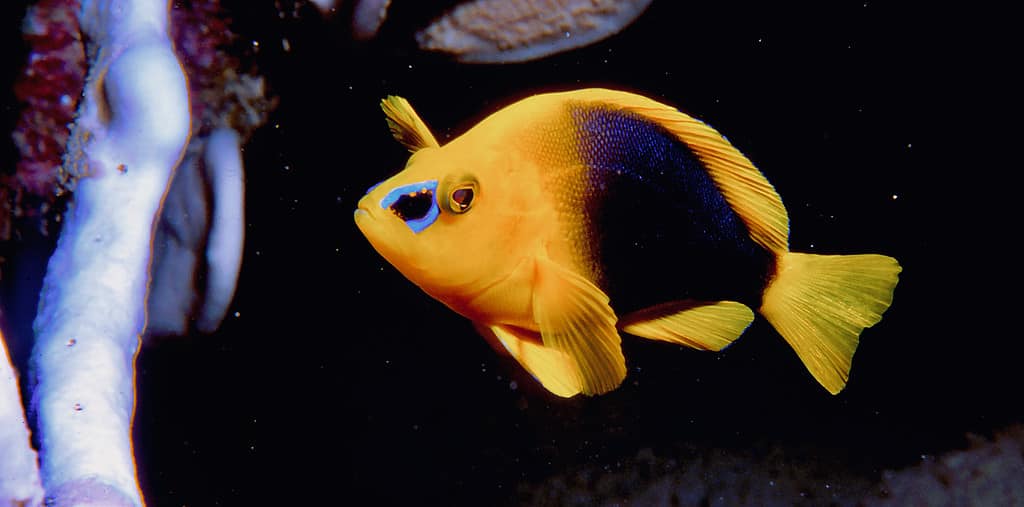
Most hamlets measure around 5 inches long and come in a range of colors from yellow to blue to white to black.
©iStock.com/Mark Silverstone
Hamlet fish belong to the genus Hypoplectrus in the family Serranidae. These tiny saltwater fish primarily live around coral reefs in the Caribbean Sea and the Gulf of Mexico. Generally speaking, hamlets live at shallow depths of no more than 100 feet below the surface.
Most hamlets measure around 5 inches long and come in a range of colors from yellow to blue to white to black. Their diet consists mainly of smaller fish and crustaceans such as shrimp.
Hamlets rank as one of the few known simultaneous hermaphroditic vertebrates. This means that they possess both male and female reproductive systems at the same time. When mating, hamlets take turns acting as male or female. While hamlets tend to select other hamlets of the same species when mating, they will also hybridize with other species.
9. Hammerhead Shark (Sphyrindae)
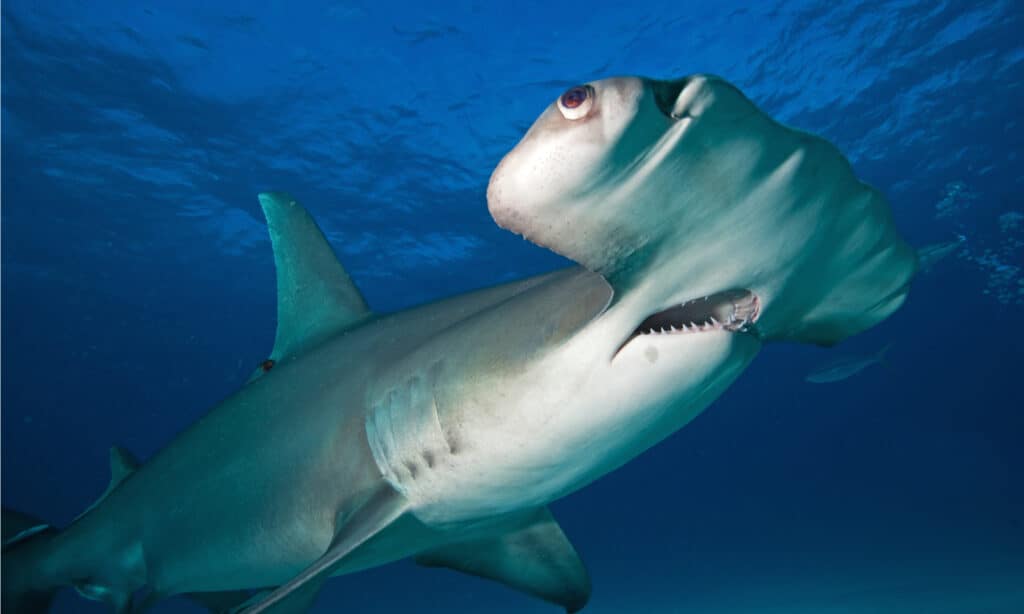
Hammerhead sharks vary in size from 3 to 20 feet long and from 3 to 1,300 pounds.
©Martin Prochazkacz/Shutterstock.com
When it comes to fish that start with H, the hammerhead shark is likely the most infamous. In total, the hammerhead family Sphyrnidae contains 9 different species. You can find hammerhead sharks in warm water along coastlines worldwide.
Hammerhead sharks vary in size from 3 to 20 feet long and from 3 to 1,300 pounds. While they vary in size, they all possess characteristic hammer-shaped heads and small mouths. In terms of color, they range from light gray to gray brown.
Hammerhead sharks mate once per year and give birth to live young. Unlike most sharks, they often collect in schools during the day to feed. Their diet consists of fish, crustaceans, stingrays, and cephalopods. Unfortunately, the IUCN lists most hammerhead shark species as Endangered or Critically Endangered.
10. Handfish (Brachionichthyidae)

Smooth handfish use their hand-shaped fins to walk along the sea floor.
©be_u_and_i/Shutterstock.com
Handfish belong to the anglerfish family Brachionichthyidae. You can find handfish on the sea floor off the coasts of Australia and Tasmania.
On average, handfish max out at just under 6 inches long. They grow tooth-like scales known as denticles, which is why some people call them warty anglers. Their pectoral fins appear handlike, hence the name handfish.
Unlike most fish, handfish do not swim but rather use their hand-like fins to “walk” along the sea floor. Little is known about the distribution, population, and behavior of handfish. The IUCN lists several known species of handfish as Endangered.
11. Hawkfish (Cirrhitidae)

Hawkfish live on coral reefs and rocky substrates around the world.
©Pavaphon Supanantananont/Shutterstock.com
The hawkfish family Cirrhitidae contains approximately 33 different species spread across 12 genera. These small marine fish inhabit shallow water worldwide and are generally found around rocky substrates and coral reefs.
Hawkfish have oblong-shaped bodies and a continuous dorsal fin containing 10 spines and between 11 and 17 soft rays. They range in size and color, with most species measuring around 12 inches long and featuring bright colors and patterns.
Hawkfish are carnivores that mostly prey on small crustaceans. They hunt by diving down onto prey beneath them like a hawk, hence their name. While unpopular as food fish due to their size, they are commonly kept as pets or in public aquariums.
12. Herring (Clupeidae)
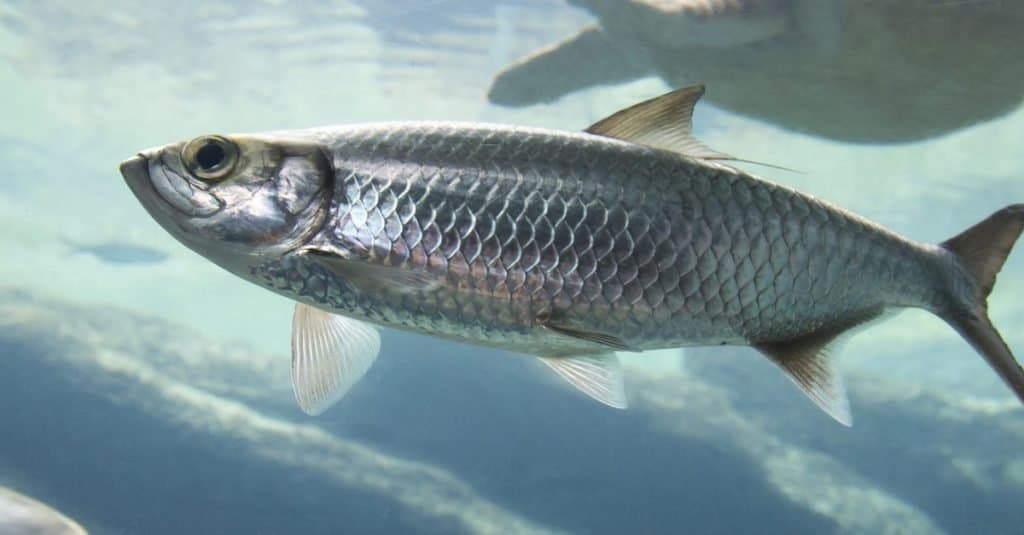
Herring are among the most popular food fish in the world.
©Four Oaks/Shutterstock.com
The term herring is most often used to refer to fish in the family Clupeidae. The type genus, Clupea, contains two species, the Atlantic herring (Clupea harengus) and the Pacific herring (Clupea pallasii). You can find herring all over the world, particularly in the northern Atlantic and Pacific Oceans.
The various herring species share several common characteristics, including a single soft, spineless dorsal fin. Their bodies normally appear silver and measure less than 18 inches long.
Herring rank as some of the most important food fish in the world, particularly the Atlantic and Pacific herring. They live in large schools, which makes them relatively easy to catch in large numbers. Their diet consists mainly of worms, krill, and plankton.
13. Hog Sucker (Catostomidae)
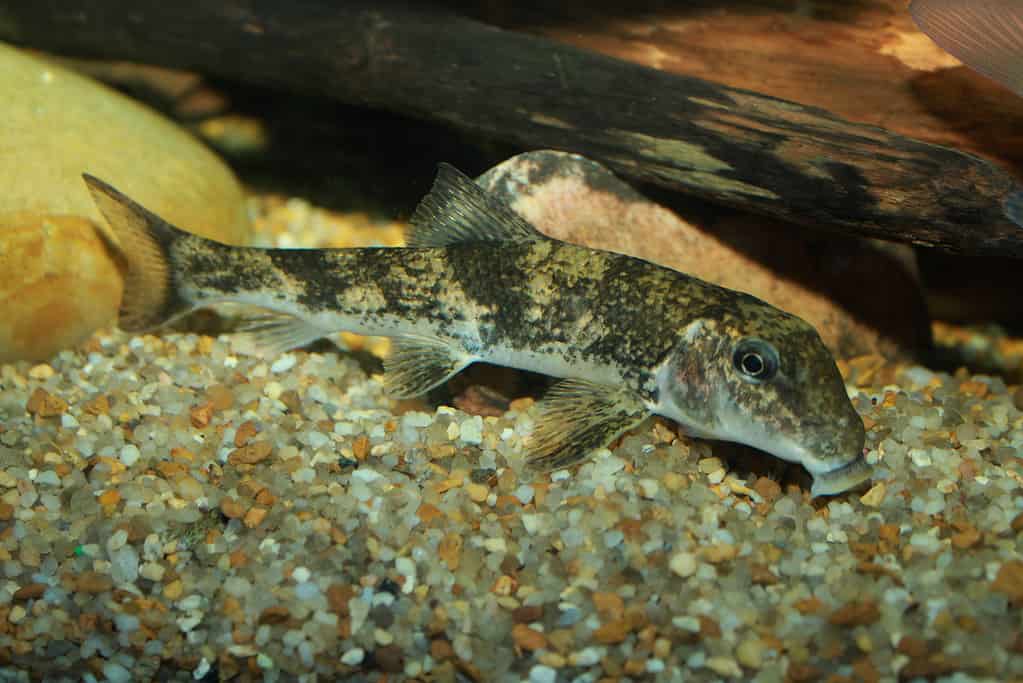
Hog suckers possess square-shaped heads and protruding lips that they use to rummage through rocks on the bottoms of streams and rivers for food.
©Brian Gratwicke/Wikimedia Commons – License
Hog suckers belong to the genus Hypentelium in the family Catostomidae. The genus contains 3 species, all of which are native to the United States and Canada. You can find these freshwater fish in both warm and cool freshwater rivers and streams.
Hog suckers can range in size from 6 to 13 inches long. They possess square-shaped heads and protruding lips that they use to rummage through rocks on the bottoms of streams and rivers for food. While they vary in color, all 3 hog sucker species have white bellies and pale or dark stripes along the back.
Hog suckers feed on insects, mollusks, crustaceans, detritus, and aquatic vegetation such as algae. While relatively rare due to their limited distribution, hog suckers aren’t considered an Endangered or Threatened species by the IUCN.
14. Horn Shark (Heterodontus francisci)

Horn sharks have orbital ridges that look like horns.
©Philip Garner/Shutterstock.com
The horn shark is a member of the bullhead shark family Heterodontidae. You can find these nocturnal predators along the western coastline of North America, from northern California to Baja California. In summer, they live in shallow water and then migrate to deeper water during winter.
Horn sharks have short heads and ridges over the eyes that resemble horns, hence their name. A relatively small species, the average horn shark measures around 3.3 feet long. Small dark spots cover the grayish-brown body, and the two dorsal fins feature large spikes at the ends.
Horn sharks are nocturnal predators that tend to hide in caves or crevices during the day. They feed mostly on mollusks, crustaceans, and sea urchins. To break through the tough shells of their prey, horn sharks rely on their powerful jaws, which can produce a bite force of around 135 Newtons.
15. Horsefish (Congiopodidae)

Horsefish lack scales on the head and body, while the skin feels coarse to the touch.
©iStock.com/Madelein_Wolf
Horsefish in the family Congiopodidae also go by the name pigfishes or racehorses. You can find horsefish in the Southern Hemisphere near the sea floor at depths up to 2,000 feet.
Horsefish lack scales on the head and body, while the skin feels coarse to the touch. They feature a continuous dorsal fin that features anywhere from 8 and 21 spines as well as 8 to 14 soft rays. At maximum size, horsefish can measure approximately 31 inches long.
Horsefish tend to hunt at night for crustaceans, sea urchins, mollusks, and marine worms. They use their long snouts to search crevices for food and are otherwise rather sedentary when not hunting.
The Largest Fish That Starts with the Letter H
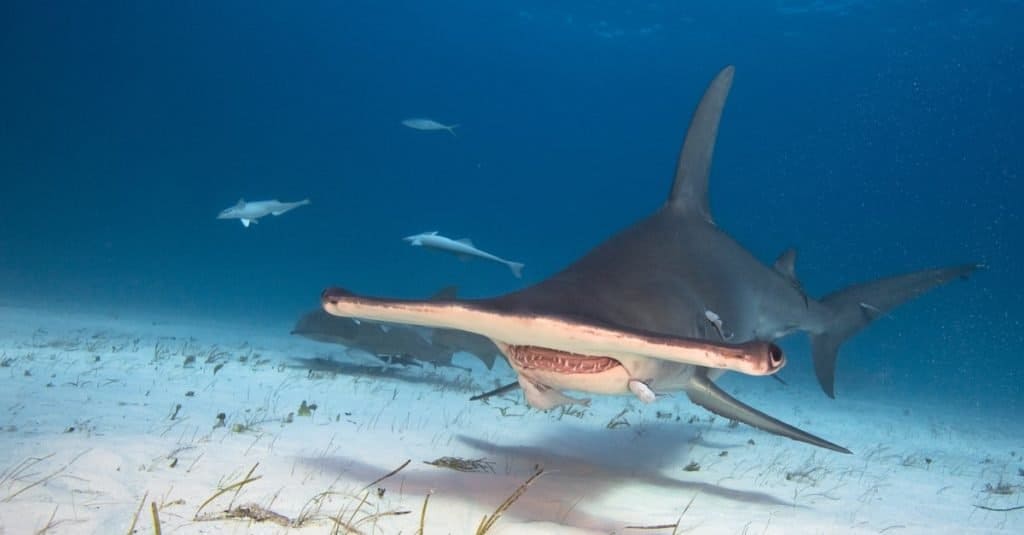
This shark’s unusual name comes from the unusual shape of its head, an amazing piece of anatomy built to maximize the fish’s ability to find its favorite meal: stingrays.
©frantisekhojdysz/Shutterstock.com
Hammerhead sharks rank as the largest fish that starts with the letter H. Of the 9 known species, the great hammerhead shark (Sphyrna mokarran) ranks as the largest.
On average, great hammerhead sharks measure around 11 feet long and weigh 500 pounds. That said, exceptionally large specimens can grow up to 20 feet long and weigh nearly 1,300 pounds.
Despite their large size and sharp teeth, great hammerhead sharks tend to act rather shy around humans. While they may charge and even bite divers, great hammerhead shark bites are rarely fatal. The IUCN classifies the great hammerhead shark as Critically Endangered due to overfishing.
Summary of 15 Fish That Start With H
| # | Common Name | Scientific Name |
|---|---|---|
| 1 | Haddock | Melanogrammus aeglefinus |
| 2 | Hagfish | Myxinidae |
| 3 | Hairtail | Trichiuridae |
| 4 | Halfbeak | Hemiramphidae |
| 5 | Halfmoon | Medialuna californiensis |
| 6 | Halibut | Pleuronectidae |
| 7 | Halosaur | Halosauridae |
| 8 | Hamlet | Serranidae |
| 9 | Hammerhead Shark | Sphyrinidae |
| 10 | Handfish | Brachionichthyidae |
| 11 | Hawkfish | Cirrhitidae |
| 12 | Herring | Clupeidae |
| 13 | Hog Sucker | Catostomidae |
| 14 | Horn Shark | Heterodontus francisci |
| 15 | Horsefish | Congiopodidae |
The photo featured at the top of this post is © HakBak/Shutterstock.com
Thank you for reading! Have some feedback for us? Contact the AZ Animals editorial team.







